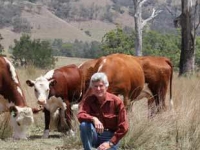Selection, nutrition profitable in Hunter

1 December 2012
Kay Payne never at first intended to establish Elite Poll Herefords and sell over 40 bulls a year from her Upper Hunter property. However a thorough herd recording and selection program to produce pasture fed bulls suited to her local environment evolved to the point where she now sells surplus bulls and some females throughout eastern Australia. When the Elite herd moved to the Upper Hunter in 1990, the property was unimproved and pastures consisted mostly of wiregrass, with little or no legume content. Intensive selection was required for the herd to perform on those pastures without the addition of grain supplements.
At she upgraded herd genetics Kay also improved pastures by adding single superphosphate (plus molybdenum intermittently) or sulphur fortified fertilisers, plus sub clover, when the seasons and income permitted. Slashing and herbicides initially controlled saffron thistles and enabled subclover establishment. Since the pastures have been improved, and ground cover managed, these measures have only been required after drought. Excellent records of the amount of fertiliser applied, plus cow numbers, yearling weights and sale carcase weights meant that returns on investment for pasture improvement and genetic selection made her calculations easy. This delighted the Scone More Beef From Pastures group when they met recently at the property.
Using current costs of fertiliser (plus application), and liveweight prices for aged cows and yearling steers and heifers, the analyses showed a total return on investment has been 2.4:1 since 1990.In current dollars, that equates to an additional $45,000 per year on the 1440 hectare property. “I still believe that outlaying money to correct soil deficiencies and adding suitable legumes is the safest investment for any beef business,” Kay Payne said. “I was interested to see the return on investment figures calculated at the field day and feel that, if anything, they’re conservative.” Genetic progress and pasture improvement are complementary. “It’s no use having increased genetic potential for growth, without the pasture for stock to express that potential, likewise, it’s no use having valuable pastures without the right stock ,” she said. Field day participants also discussed the practicalities of feeding white cottonseed and other supplements, as the Hunter area is still severely affected by prolonged dry weather.
Contact Todd Andrews, Armidale, Ph: 02 6770 1831 Mobile: 0427 987 405, todd.andrews@dpi.nsw.gov.au
- Todd Andrews
